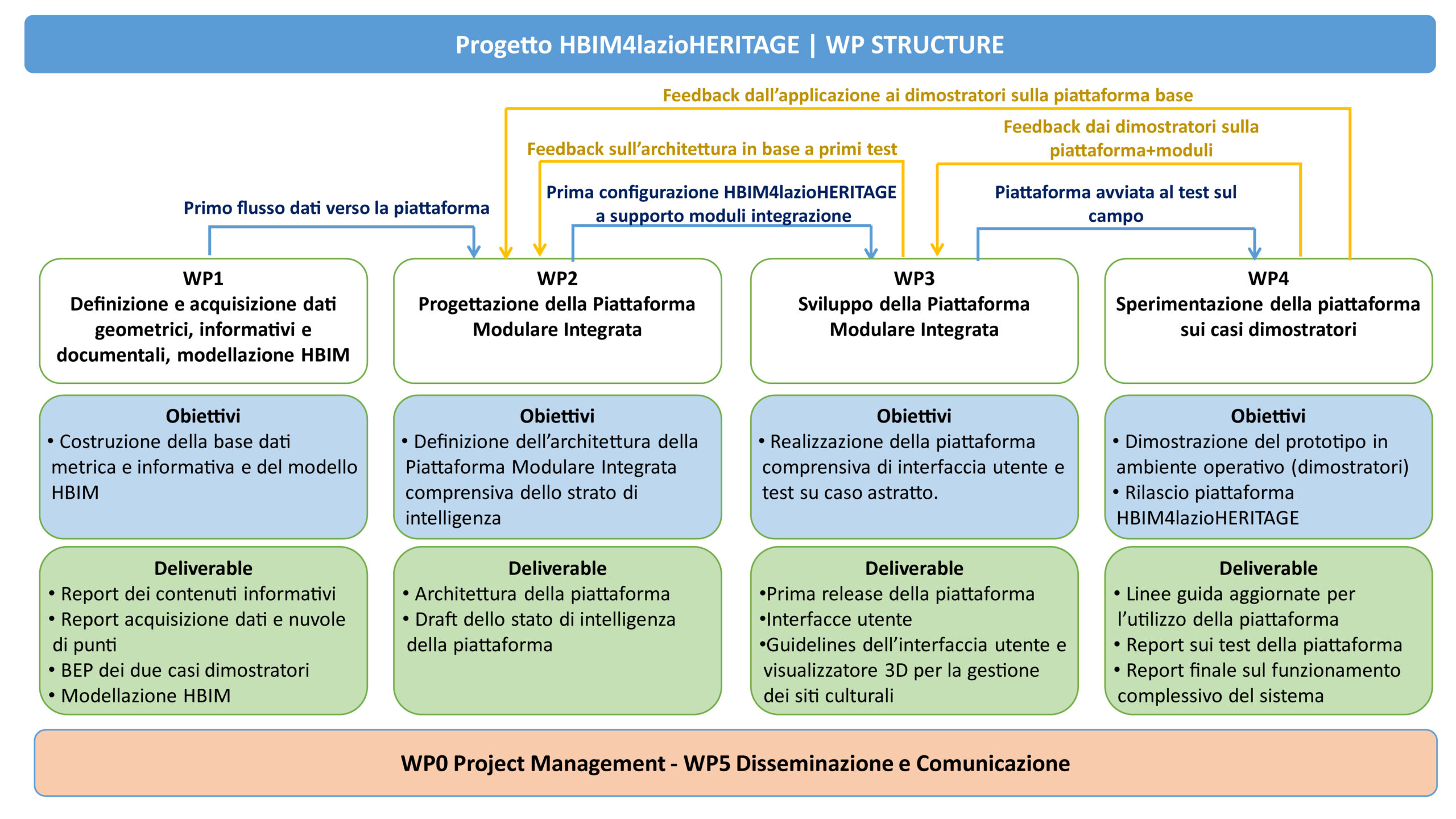The implementation of the platform, through the development and testing phases, addresses the validation of a cloud-based 3D integrated information system prototype that, by exploiting the most advanced potential of HBIM modeling, on the one hand allows to collect and organize in a single digital environment the geometric data and the various information available on cultural sites (textual, archival, diagnostic, etc.), and on the other hand to integrate in a cloud platform some useful tools for the management of management, programming and monitoring activities.
WP0 - Project Management
Coordinator: Elena Gigliarelli
WP0 aims to ensure the coordination and management of the project in relation to administrative, legal and financial issues as well as the relationship with the lender. Project management is structured in the initialization of the project to acquire technical and human resources to start activities; a planning phase in which a summary of project objectives and a refinement of the management plan is carried out; control of the proper execution of project activities, with risk analysis, monitoring and control actions to guide implementation and identify areas where corrective actions are needed.
WP1 - Construction of the metric and information database and the HBIM Model
Coordinator: Carlo Bianchini
WP1 consists of an initial activity of defining the information content to be managed by the system to meet the intended uses, a subsequent phase of collecting the geometric, informational and documentary data that will finally be implemented for the construction of HBIM models of the demonstrator cases. Preparatory activities to the construction of the model will be: the definition of an appropriate semantic classification of the technological components present in the historic buildings, which will allow the realization of a consequent Model Element Table specifically for this type of buildings, and the drafting of a Building Execution Plan (PGI according to UNI 11337) that will allows the subsequent modeling work to be structured in a manner consistent with the information content defined in the initial phase. In the same document will be also indicated the outputs generated directly from the model (plans, sections, schedules, etc.).
WP2 - Defining a cloud-based platform
Coordinator: Elena Gigliarelli
WP2 concerns the definition of the structure and construction of a database external to those of the Bim Authoring Tools, for the implementation of data not directly manageable within existing BIM platforms and/or from external data sources such as a monitoring sensor network (IoT). Such a framework has as its main data repository the file in the Industry Foundation Classes (IFC) interchange format created through export of the HBIM model produced in WP1, to then ensure linkage to other data sources of static type (additional data to the HBIM model related to disciplinary focus or model specification through metadata and paradata) and dynamic data (real-time data from, for example, IoT monitoring networks). Also included in the structuring of the platform is the definition of the GUI (Graphic User Interface) for using the model and querying the database according to specific uses (which will then be final in WP3),and the definition of the platform intelligence for decision support (e.g., the identification of certain thresholds for values to be monitored, to be used as triggers for flags of warnings by the platform).
WP3 - Integration of separately accessible functions into a unified tool
Coordinator: Filippo Calcerano
During WP3, the platform designed in WP2 will be implemented through a trial and error process with operational testing of exchange, integration and processing of data. Leaning on existing software tools, GUI modules will be developed that will make the system easily usable by various users, depending on the different intended uses, taking full advantage of the database and its intelligence and decision support elements. The idea is to develop as lightweight a web interface as possible for managing queries and 3D visualizations and data processed by the platform. This will require a collaborative design between the ISPC-CNR and DSDRA teams to translate the platform performance requirements highlighted in WP2, the result of user needs, into consequent web interfaces linked to the platform itself.
WP4 - Field analysis and verification of systems and instruments with data analysis and feedback from current operation
Coordinator: Carlo Bianchini
The platform's systems and tools, so far tested only under controlled experimental conditions, will be verified through application on demonstrator cases. The effectiveness of the various modules of the platform in meeting the needs expressed by the uses of the system will be evaluated and, if it does not guarantee the expected performance, will lead to possible corrective actions in a recursive process of further development aimed at the consolidation of the HBIM4lazioHERITAGE platform until the validation of the release final release.
WP5 - Dissemination of the HBIM4lazioHERITAGE platform among the scientific community and stakeholders of Places of Culture
Coordinator: Luigi Biocca
WP5 aims to promote the HBIM4lazioHeritage platform and its functionality to the scientific community, the business and professional world, and stakeholders related to Places of Culture. Given the nature of the project, special attention will be paid to dissemination opportunities at the national level as well.

